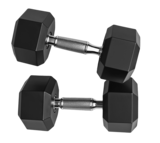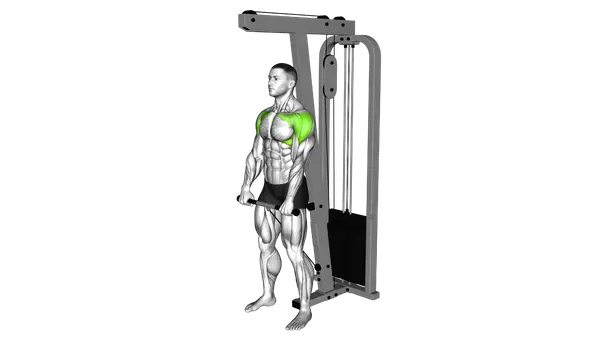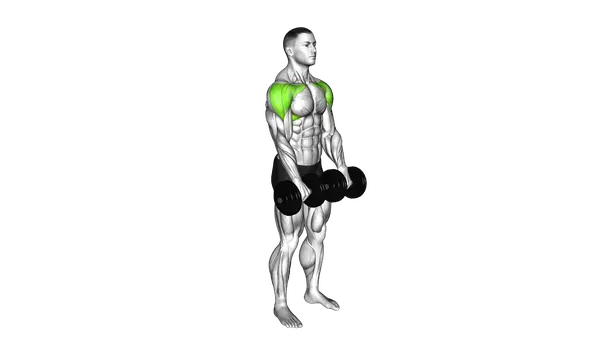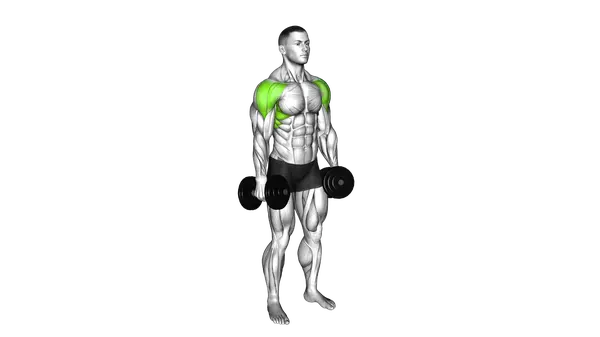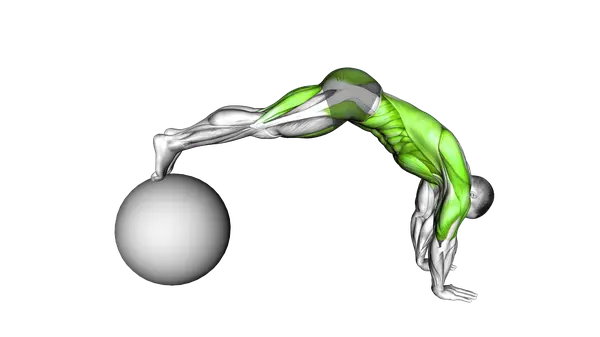Exercise
Weighted Front Raise
How to Perform - Weighted Front Raise
- Stand with feet shoulder-width apart while holding a dumbbell in each hand in front of your thighs with palms facing your body.
- Brace your core and maintain a neutral spine position, with shoulders pulled back and down away from your ears.
- Keeping a slight bend in your elbows (about 10-15 degrees), inhale and prepare for the movement.
- Exhale as you raise the weights directly in front of you with palms facing down, lifting until your arms are parallel to the floor.
- Pause briefly at the top position while maintaining tension in your shoulders and keeping your wrists neutral (in line with your forearms).
- Inhale as you slowly lower the weights back to the starting position with controlled movement, resisting gravity.
- Maintain proper posture throughout the exercise, avoiding the tendency to arch your lower back or lean backward as you lift.
- Reset your position before beginning the next repetition, ensuring your shoulders remain relaxed and away from your ears.
Important information
- Keep the weight light enough to maintain proper form—this exercise targets the anterior deltoids effectively even with moderate resistance.
- Make sure your wrists stay straight and don't bend backward during the movement to avoid strain.
- Control the tempo of both the raising and lowering phases to maximize muscle engagement and prevent momentum from taking over.
- If you experience shoulder pain, try alternating arms or reducing the height of the lift to a level that feels comfortable.
Primary Muscles
Muscle Groups
Mechanic
Risk Areas
Built for progress
Take the guesswork out of training
Create personalized AI-powered workout plans that evolve with you. Train smarter, track every rep and keep moving forward, one workout at a time.






The weighted front raise stands as a cornerstone isolation movement for developing impressive shoulder definition and strength. This intermediate-level exercise primarily targets the anterior (front) deltoids while also engaging the medial (side) deltoids as secondary movers, creating balanced shoulder development that enhances your overall upper body aesthetics.
Popular among bodybuilders for its ability to sculpt detailed shoulder caps, the front raise can also be incorporated into high-intensity interval training (HIIT) routines when performed with lighter weights and higher repetitions. This versatility makes it valuable whether you're focused on hypertrophy or conditioning work.
What distinguishes the weighted front raise is its precision in activating the front shoulder muscles, an area that contributes significantly to that coveted V-taper physique. The controlled nature of this movement allows for intense muscle fiber recruitment without the need for excessive weight, making it particularly effective for stimulating growth while minimizing joint stress.
Strength athletes incorporate front raises strategically to address potential shoulder imbalances that might develop from pressing-heavy programs. By strengthening the anterior deltoids in isolation, you create more stable and resilient shoulders that can support heavier lifts in compound movements like the bench press and overhead press.
For optimal results, many experienced lifters include weighted front raises toward the end of their shoulder workouts after completing more compound pressing movements. This sequencing ensures the smaller deltoid muscles are pre-exhausted by heavier work before being isolated and pushed to their growth threshold.
Whether using dumbbells, weight plates, kettlebells, or resistance bands, the weighted front raise delivers remarkable shoulder development when performed consistently with proper form and appropriate loading. The exercise stands the test of time because it addresses a fundamental need in any well-designed strength program – directly targeting the anterior deltoid complex for both functional strength and aesthetic development.
FAQ - Weighted Front Raise
Weighted front raises primarily target the anterior (front) deltoids while also engaging the medial (side) deltoids as secondary movers. Additionally, your upper trapezius, serratus anterior, and core muscles work as stabilizers throughout the movement.
Start with lighter weights (5-15 pounds for beginners) as this exercise is meant for muscle isolation, not maximum strength. You should be able to maintain perfect form through all reps without swinging or using momentum; if you can't raise the weight without body English, it's too heavy.
Keep your shoulders depressed (away from your ears) throughout the movement, maintain a slight bend in your elbows, and never raise weights above shoulder height. If you have existing shoulder issues, try using the neutral grip variation (thumbs pointing up) which often reduces impingement risk.
Incorporate weighted front raises 1-2 times weekly as part of your shoulder or upper body training. Since the anterior deltoids also get activated during pressing movements like bench press and push-ups, be mindful not to overtrain them by scheduling front raises at least 48 hours after heavy pressing sessions.
The three most common mistakes are using momentum by swinging the weights, raising the weights too high (above shoulder level), and shrugging your shoulders during the movement. Focus on controlled movement, proper range of motion, and keeping your shoulders down and back to maximize results while minimizing injury risk.

